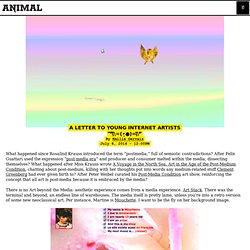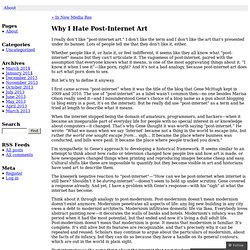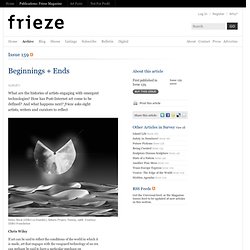

Revue d'art contemporain. On a pu remarquer il y a déjà quelque temps l’apparition du terme « post-Internet » visant à qualifier et à analyser les pratiques d’une nouvelle génération d’artistes, nés dans les années quatre-vingt et marqués par l’influence d’Internet lors de leur formation artistique dans les années deux mille.

Cette dernière décennie fut en effet celle de la démocratisation du web (avec sa version 2.0), de l’apogée des réseaux sociaux, d’un accès illimité à la connaissance et de la vente en ligne, autant d’outils propices à la création artistique à une époque où semble acquis le principe d’interdisciplinarité dans les arts visuels. Ce vocable semble cependant se concentrer sur des pratiques artistiques considérant Internet non seulement comme un outil de travail mais aussi comme une manne esthétique en soi, autosuffisante, permettant d’explorer et d’habiter l’incommensurable complexité de nos sociétés contemporaines. DIS Competing Images, 2012. Antoine Catala. Topologies, 2010. Timur Si-Qin. A Letter To Young Internet Artists ̿ ̿'̵͇̿̿=( What happened since Rosalind Krauss introduced the term “postmedia,” full of semiotic contradictions?

After Felix Guattari used the expression “post-media era” and producer and consumer melted within the media, dissecting themselves? What happened after Miss Krauss wrote A Voyage in the North Sea. Art in the Age of the Post-Medium Condition, chatting about post-medium, killing with her thoughts put into words any medium-related stuff Clement Greenberg had ever given birth to? After Peter Weibel curated his Post-Media Condition art show, reinforcing the concept that all art is post-media because it is embraced by the media? There is no Art beyond the Media: aesthetic experience comes from a media experience. Mouchette Bonjour. му lιƒє ιѕ dєlιcαтєlу ωєll вαlαиcєd. єνєяу dαу ι ωαкє, иσт киσωιиg нσω ѕнιтту ι’ll ƒєєl. (reload) Why I Hate Post-Internet Art « I really don’t like “post-internet art.”

I don’t like the term and I don’t like the art that’s presented under its banner. Lots of people tell me that they don’t like it, either. Whether people like it, or hate it, or feel indifferent, it seems like they all know what “post-internet” means but they can’t articulate it. The vagueness of post-internet, paired with the assumption that everyone knows what it means, is one of the most aggravating things about it. “I know it when I see it”—like porn, right? But let’s try to define it anyway. I first came across “post-internet” when it was the title of the blog that Gene McHugh kept in 2009 and 2010.
When the internet stopped being the domain of amateurs, programmers, and hackers—when it became an inseparable part of everyday life for people with no special interest in or knowledge about computers—it changed. I’m sympathetic to Gene’s approach to developing a historical framework. What's Postinternet Got to do with Net Art? Courtesy grouphab.it and Harm van den Dorpel.

An extended and altered version of this text will be published in... You Are Here: Looking at After the Internet (Cornerhouse Books 2014), edited by Omar Kholeif. Earlier this month, Rhizome presented a panel discussion at the ICA in London titled "Post-Net Aesthetics. " Following in the wake of prior panels (titled "Net Aesthetics 2.0") which were organized by Rhizome in 2006 and 2008, this edition was precipitated by the recent discussion of postinternet practices by a number of art institutions and magazines, including Frieze. We invited a longtime Rhizome collaborator, critic and curator Karen Archey, to chair and organize the panel, and what emerged was a wide-ranging and extremely generative conversation in which participants began to articulate some of the shifts they'd seen in artistic practice in recent years, while critiquing those shifts and their framing as "postinternet.
" With Elements of Web 2.0 (2006) Beginnings + Ends. Beginnings + Ends Survey What are the histories of artists engaging with emergent technologies?

How has Post-Internet art come to be defined? And what happens next? Frieze asks eight artists, writers and curators to reflect Heinz Mack (ZERO co-founder), Sahara Project, Tunisia, 1968. Chris Wiley If art can be said to reflect the conditions of the world in which it is made, art that engages with the vanguard technology of an era can perhaps be said to have a particular purchase on contemporaneous visions of the arc of the future. Interestingly, the current crop of artists who have been lumped into the ‘Post-Internet’ category have largely evaded this type of analysis. On the whole, these postwar artistic engagements with technology were reflective of the cautious optimism of their time. In contradistinction to this 20th-century vision, prognosticating artists of the 21st century would seem to have foreclosed any optimistic vision for the future. Katja Novitskova Constant Dullaart Karen Archey.